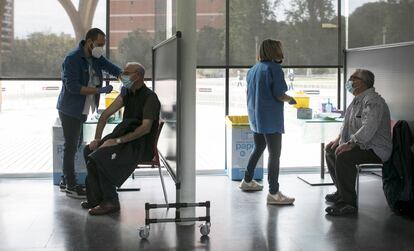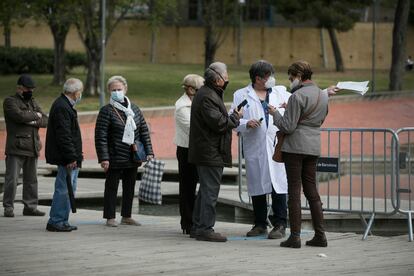Nearly half of 70-79 age group in Spain have received first dose of Covid-19 vaccine
The pace of the vaccination drive is expected to accelerate after the EMA ruled the benefits of the Janssen medication outweigh the risks. Several regions have also asked for these shots to be used on younger citizens


The vaccination of the age groups most vulnerable to Covid-19 is racing ahead. According to the latest report by the Spanish Health Ministry, released Tuesday, 45.4% of people in the 70-79 age group have received at least one dose of the vaccine. This is more than double the figure reported last week, when it stood at 21.4%. Up until recently, vaccination of this demographic had been sidelined: the Pfizer-BioNTech and Moderna vaccine was prioritized for the 80-and-over age group and the use of the Oxford-AstraZeneca shots was restricted to people aged between 60 and 69 due to concerns over very rare blood clot cases in younger patients.
Now that 98.8% of the 80-and-over population has been given the first dose of the vaccine, Pfizer and Moderna shots are being prioritized for the 70-to-79 population. Around 66% of the 1.4 million Pfizer and Moderna doses administered in the last week went to this age group. The rest were used to provide the second shot to the 80-and-over population and frontline health workers, and the first dose to people with serious conditions that make them especially vulnerable to the virus, such as cancer or transplant patients.
The vaccination of the 60-69 age bracket is also picking up speed, with 38.5% having now received the first dose of the vaccine. But the overall number remains low. According to the latest report, 20% of the Spanish population has received the first dose of the vaccine while 7.3% have received the complete two doses needed for full protection.
Despite this, experts say the vaccination drive is already having an impact on transmission rates. While increased social activity and movement over the Easter break were expected to lead to a surge in new coronavirus cases, this has not happened. The latest Health Ministry report on the epidemiological situation, released on Tuesday evening, showed that the rise of the fourth wave is starting to stabilize. According to the data, the 14-day cumulative number of cases per 100,000 inhabitants stands at 231 – the same figure reported on Monday. If this trend is confirmed, the fourth wave will be much smaller than the second and third, when the incidence rate reached 500 and 1,000 cases, respectively.
“The vaccination is affecting the curve because we are seeing that the impact of Easter week was much smaller than the long weekends in December [which marked the beginning of the third wave], for example,” said José Luis Barranco, the spokesperson from the Spanish Society of Preventive Medicine, Public Health and Hygiene (Sempshp).
Barranco, however, warned that Spain cannot let its guard down. “We can’t let ourselves get carried away by emotion or get used to such high incidence rates because Covid is continuing to overwhelm the entire healthcare system and affects everything,” he said. “An incidence rate of 250 cases per 100,000 is extreme risk.”
According to the latest Health Ministry report, the number of people being treated in hospital with Covid-19 fell on Tuesday to 10,345 – a drop of 102 from Monday. Admissions to intensive care units (ICUs), however, rose by 13, with 2,289 Covid-19 patients currently in ICUs across the country. Madrid has the highest ICU occupancy rate of all the regions, with 45% of beds taken up by Covid-19 patients, followed by La Rioja (45%) and Catalonia (38%). The report added 114 fatalities to the official death toll, which now stands at 77,216.
Janssen vaccine
The rollout of the vaccination drive is expected to speed up further after the European Medicines Agency (EMA) gave the green light on Tuesday to the Janssen vaccine from US pharmaceutical company Johnson & Johnson. The European rollout of the Janssen vaccine was suspended last week while the EMA examined serious blood clot cases in the United States that occurred within three weeks of the person receiving the shot. While the regulator found a “possible link” between these cases and the Janssen vaccine, it said that its benefits outweighed the risks.
“Thousands of people are still dying every day of Covid-19 and these vaccines play an immensely important role in combating this pandemic,” said Emer Cooke, the EMA’s executive director. The EMA did, however, recommend that a warning be added to the vaccine’s product information.

According to Barranco, the Janssen vaccine – which, unlike AstraZeneca, Moderna and Pfizer, only requires one dose for full protection – will be “a very strong push for the vaccination drive.” Spain is expected to receive 300,000 doses of the Janssen vaccine this week, and a total of 5.5 million in the second quarter. “There may be two odd weeks until everything is clarified and the vaccination strategy is updated, but when May begins, the situation will change radically: we will vaccinate much more and much more quickly,” said Barranco.
Under Spain’s current vaccination strategy, the Janssen vaccine is reserved for people in the 70-to-79 age group. But several regions – which are in charge of the vaccination drive as well as controlling the pandemic in their territories – have asked the Public Health Commission to allow the shot to be administered to other priority groups.
“Several regions have asked for the strategy to be made more flexible so that, although the elderly are prioritized, this vaccine can be used on other groups, independently of age,” one regional leader told EL PAÍS.
The Public Health Commission has also decided against delaying the second shot of the Pfizer and Moderna dose in order to administer more people with the first dose – a request made by the regional governments of Catalonia, Madrid and Andalusia. Instead, the second dose will be administered between 21 and 28 days after the first, as outlined by the usage guidelines for each vaccine.
Despite the temporary pause of the Janssen vaccine, the Spanish government is confident it will still be able to reach its goal of vaccinating 70% of the adult population by the end of summer.
With reporting by Oriol Güell and Guillermo Abril.
English version by Melissa Kitson.
Tu suscripción se está usando en otro dispositivo
¿Quieres añadir otro usuario a tu suscripción?
Si continúas leyendo en este dispositivo, no se podrá leer en el otro.
FlechaTu suscripción se está usando en otro dispositivo y solo puedes acceder a EL PAÍS desde un dispositivo a la vez.
Si quieres compartir tu cuenta, cambia tu suscripción a la modalidad Premium, así podrás añadir otro usuario. Cada uno accederá con su propia cuenta de email, lo que os permitirá personalizar vuestra experiencia en EL PAÍS.
¿Tienes una suscripción de empresa? Accede aquí para contratar más cuentas.
En el caso de no saber quién está usando tu cuenta, te recomendamos cambiar tu contraseña aquí.
Si decides continuar compartiendo tu cuenta, este mensaje se mostrará en tu dispositivo y en el de la otra persona que está usando tu cuenta de forma indefinida, afectando a tu experiencia de lectura. Puedes consultar aquí los términos y condiciones de la suscripción digital.
More information
Últimas noticias
Alain Aspect, Nobel laureate in physics: ‘Einstein was so smart that he would have had to recognize quantum entanglement’
Imelda Castro, the woman who wants to rule the cartel battleground of Sinaloa
The new victims of the Republican war on Obamacare: Millions hit by soaring health insurance premiums
A country divided on migrant rights: Some US states expand protections while others restrict them
Most viewed
- David King, chemist: ‘There are scientists studying how to cool the planet; nobody should stop these experiments from happening’
- Reinhard Genzel, Nobel laureate in physics: ‘One-minute videos will never give you the truth’
- Oona Chaplin: ‘I told James Cameron that I was living in a treehouse and starting a permaculture project with a friend’
- Sinaloa Cartel war is taking its toll on Los Chapitos
- Mexico completes its trade shift with the entry into force of tariffs on China and countries without trade agreements










































